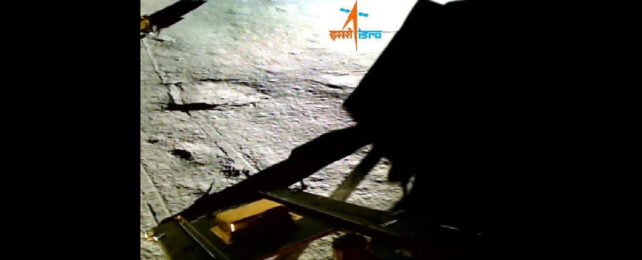India only landed on the Moon last week, but its Chandrayaan-3 mission has already made its first scientific observations of the lunar south pole.
By shooting lasers at the surface, the onboard rover has confirmed the presence of sulfur, the Indian Space Research Organisation (ISRO) has announced.
It's the first rover to ever explore the region.
"The Laser-Induced Breakdown Spectroscopy (LIBS) instrument onboard Chandrayaan-3 Rover has made the first-ever in-situ measurements on the elemental composition of the lunar surface near the south pole," ISRO said in a statement.
"These in-situ measurements confirm the presence of Sulphur (S) in the region unambiguously, something that was not feasible by the instruments onboard the orbiters."
Chandrayaan-3 Mission:
— ISRO (@isro) August 29, 2023
In-situ scientific experiments continue .....
Laser-Induced Breakdown Spectroscope (LIBS) instrument onboard the Rover unambiguously confirms the presence of Sulphur (S) in the lunar surface near the south pole, through first-ever in-situ measurements.… pic.twitter.com/vDQmByWcSL
Preliminary analyses also hint at the presence of aluminum, iron, calcium, chromium, and titanium.
"Further measurements have revealed the presence of manganese (Mn), silicon (Si), and oxygen (O)," added ISRO.
"Thorough investigation regarding the presence of Hydrogen is underway."
While China, Russia, and the US have all landed on the Moon, previous attempts by Russia and India to reach the south pole had been unsuccessful.
The south pole is thought to be the most water-rich area of the Moon, and the Chandrayaan-3 rover, known as Pragyan, will spend the next two weeks using its laser to hunt for signs of frozen water – as well as studying the atmosphere and figuring out the composition of the south pole.
Frozen water could be incredibly valuable if found on the lunar surface, seeing as it could one day be used to produce breathable oxygen for future lunar bases, and could also provide ingredients for rocket fuel that could help send missions to Mars.
The name Pragyan is derived from the Hindu word pragya, meaning the highest and purest form of wisdom, intelligence, and understanding.
The small rover weighs only 57 pounds (25.8 kg) and is roughly the size of a small German shepherd. It's equipped with the laser-based LIBS tool, but also an alpha-particle beam.
LIBS is able to detect elements by firing intense lasers at the lunar surface and generating hot plasma. By studying the light from that plasma, researchers can identify the wavelengths of different particles in that particular chunk of the Moon.
We can't wait to see what else it finds over the next few weeks.
